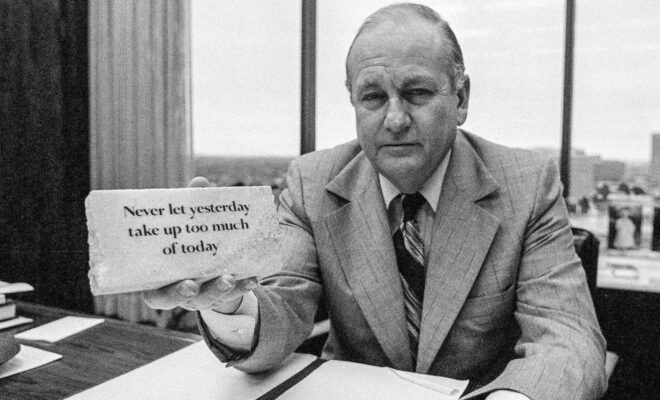Tex Schramm: Before the ‘Boys, He was the SCGA’S Frontman

While the vast number of former SCGA presidents are connected to a ball of the dimpled variety, one past prez is much more closely associated with a ball of the oblong shape.
Long before he became one of the great innovators in the history of pro sports, preceding his time as architect of “America’s Team” and far prior to his 1991 induction into the Pro Football Hall of Fame, the late/great Texas E. “Tex” Schramm (1920-2003) served as the 20th president of the SCGA.
Playing out of San Gabriel CC, Schramm served his SCGA role in 1943, the same year San Gabriel CC began hosting the famed (and impressively sartorial) Cravens Invitational, which debuted in 1925.
Born in San Gabriel to native Texans (hence his first name), Schramm attended Alhambra High School, graduating in 1938. During his prep years with the Moors, Schramm participated in football and track, and was sports editor of the school newspaper, The Moor. Schramm would later be inducted into Alhambra High’s Hall of Fame.
After high school, he attended the University of Texas and briefly extended his on-field career before trading cleats for pen, sportswriting for the university’s newspaper and also writing for the Austin-American Statesman, where he earned a whopping $30 a week. After earning a degree in sports journalism, Schramm served as a member of the U.S. Army Air Corps during World War II.
Following his service, Schramm returned to SoCal, where he’d later segue his budding sports media talents into being named publicity director for the LA Rams. But first, at just 23 years old, Schramm had his tenure as the SCGA’s frontman.
The year was 1943. During those WWII years, the task of SCGA president was surely a tenuous one. According to a synopsis of SCGA historical records from this time:
“… clubs continued to struggle and close during the early part of the 1940s — to the point where by 1943 the SCGA had just 23 member clubs. Many other clubs would have closed but for the actions of handfuls of club members who rallied to keep them alive.”
The SCGA’s historical remembrance goes on to specify:
“… clubs continued to struggle and close during the early part of the 1940s — to the point where by 1943 the SCGA had just 23 member clubs. Many other clubs would have closed but for the actions of handfuls of club members who rallied to keep them alive.”
Eventually transitioning from golf to football, Schramm worked for the Rams from 1947-57, where he’d eventually ascend to the role of general manager. Among his most notable accomplishments during this time was giving a job to a kid from South Gate, Calif., named Pete Rozelle; long after taking over Schramm’s former job running Rams’ PR, Rozelle would, of course, become commissioner of the NFL from 1960-89.
Breaking briefly from the gridiron, Schramm’s own career path took him across country to New York, where he worked as an executive for CBS and oversaw the first-ever broadcast of the Winter Olympics.
Taking his talents back to football, in 1960 Schramm got the job that would become his legacy: president and general manager of the Dallas Cowboys.
Persistence and Success
After Schramm and his head coaching hire, a 36-year-old named Tom Landry, saw the Cowboys author an 0-11-1 mark in the franchise’s inaugural year and follow that with four more losing seasons, a far more fruitful path would soon emerge.
From 1966-85, Schramm helped orchestrate 20 consecutive winning seasons for the Cowboys, a run that included five Super Bowl appearances. It’s a winning streak that stands as the third-longest in the history of North American pro sports.
Along with serving as chairman of the NFL’s competition committee, bringing the ‘Boys to Thanksgiving Day and working as a fulcrum for the historic merger between the NFL and AFL, Schramm’s run of football innovations during his 29 years with the Cowboys continue to mark the San Gabriel native among the most important figures in the history of the nation’s most popular sport. Among his host of brainstorms, The New York Times would recall in his 2003 obituary:
“Schramm thought it would be a good idea for fans and players to see which way the wind was blowing, so he started the practice of putting brightly colored strips on the goal-post uprights. He also advocated the use of a referee’s microphone so that everyone in the stadium heard the decision. He helped bring in the 30-second clock between plays.
“While heading the league in Europe, he produced one innovation that carried over to the NFL: headsets in the quarterback’s helmet so that he could hear plays from the sideline.”
Closer to his former home front, the Los Angeles Times would note in its own Tex Schramm obit from ’03:
“He is credited with developing the largest radio network of any sports franchise — more than 200 stations — and was perhaps the first in professional football to institute Spanish-language broadcasts. He put the game time on the scoreboard clock, and the Dallas Cowboys cheerleaders, the first of their kind in pro sports, on the sidelines.”
The Times would go on to recognize that:
“Schramm was one of the first proponents of using instant replay to augment officiating. He also came up with the idea of … widening sideline borders (and) restarting the play clock immediately after a play ended.”
Released from his Cowboys’ role by new owner Jerry Jones in 1989, it would take a decade for the two men to mend fences and for Schramm to be deservedly enshrined by Jones in the Cowboys’ “Ring of Honor” (which, naturally, Schramm also created).












